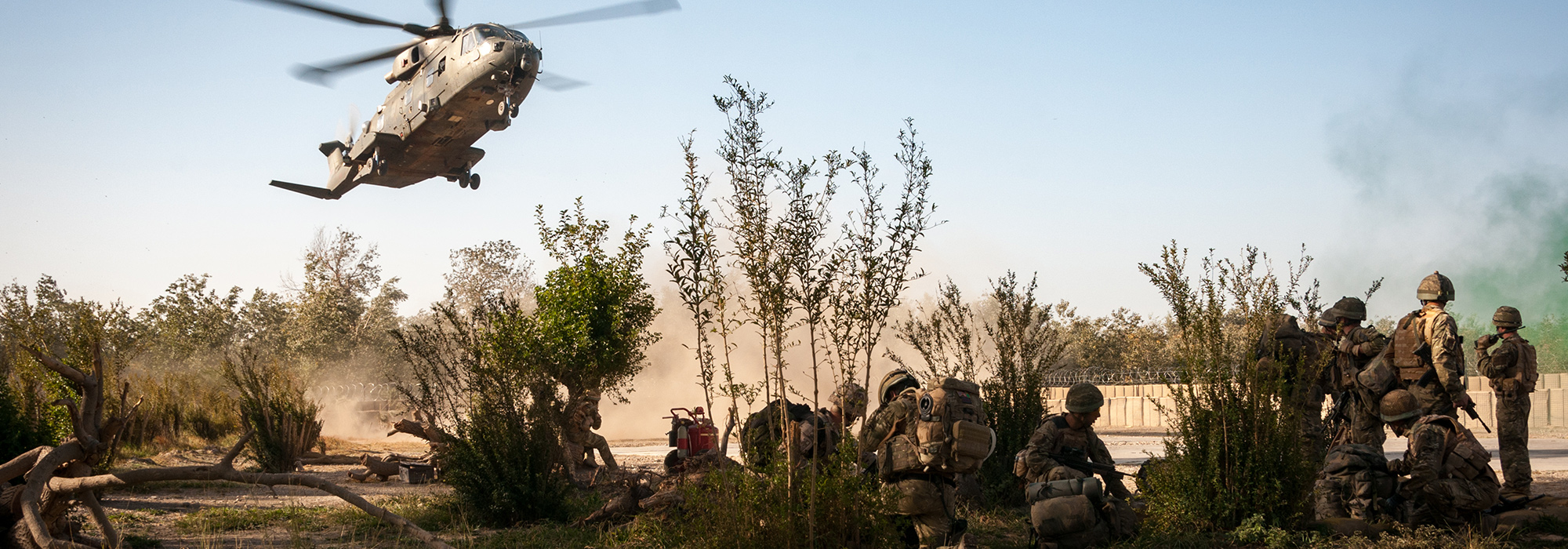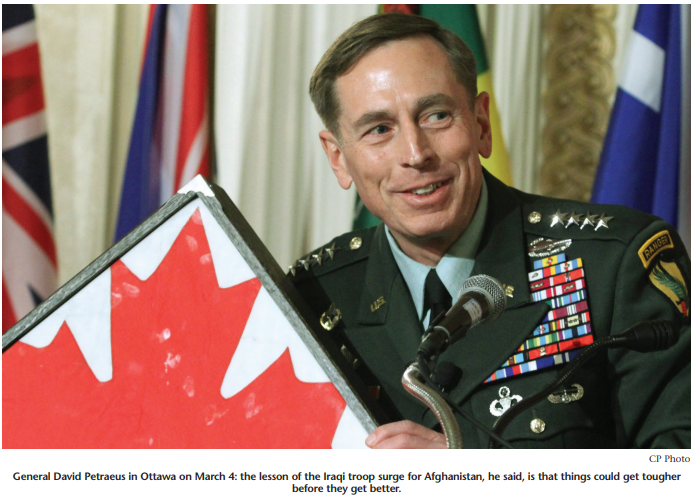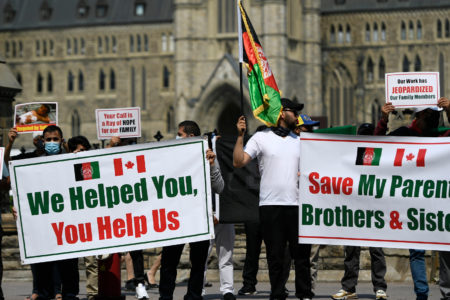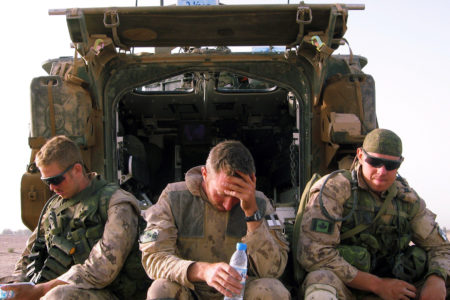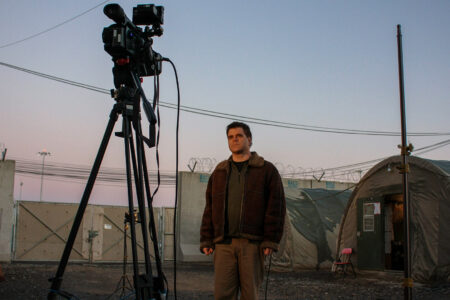
Having served with Canadian forces in Haiti, in the Balkans and in various locations in the Central Command Area of Responsibility, and even having a few intrepid souls with us in Iraq, I can affirm the enormous respect that your fellow North Americans have for those who wear the uniform of your country. Indeed, Canada is always among the handful of countries with which those of us in the US military most want to soldier when the going is tough. Those of us who wear my country’s uniform feel a very special kinship for those who wear your country’s uniform.
The real reason I’m here is to discuss the work that is being done in the place where we are most significantly serving together, that being, of course, in Afghanistan. Specifically, I’d like to discuss the changes made there over the course of the past year in a variety of areas — and to explain what we hope to achieve over the course of this year and into 2011. Because the International Security Assistance Force (ISAF) spent the past year in Afghanistan trying to get the “inputs” right, making important changes and adjustments in four key areas — organizational structures, people, concepts and resources — each of which I’ll address in turn.
Let me set the stage by recalling briefly the situation in Afghanistan in recent years. Soon after the attacks on 9/11, of course, an international coalition, including the United States and Canada, conducted an impressive campaign to defeat the Taliban, al-Qaeda and other associated extremist groups in Afghanistan. In the years that followed, however, members of the Taliban and the other extremist elements gradually reconnected, re-established the sanctuaries and infrastructure in Afghanistan and the border regions with Pakistan, and rebuilt the structures necessary to communicate, plan and carry out operations. And for what it’s worth, the cover story in the October 5, 2009, issue of Newsweek magazine explains what took place during that period better than any other description I’ve seen.
As a result of the re-establishment of the Taliban and the other elements of the so-called extremist syndicate, and despite continued achievements in certain areas by ISAF and the Afghan government, we have seen increasing violence in many areas of the country in the past three years, in particular. Indeed, the numbers of attacks reached record highs in the peak fighting season in late summer and fall last year, particularly during the period around last fall’s elections. Rising levels of violence, in turn, undermined the capacity of the Afghan government as it attempted to overcome varying degrees of corruption, an inability to provide adequate basic services for the people and the general challenges in terms of the human capital needed to establish the kind of governance that can achieve legitimacy in the eyes of the Afghan people. I hasten to note that there are many wonderful Afghan leaders who demonstrate impressive character, courage and resolve in seeking to provide a better life for their fellow Afghan citizens — and we’re privileged to work with many of those.
For many of us, the re-emergence of the Taliban and other insurgent groups, and the necessity to reverse the downward trend in security, underscored the need for ISAF to posture for a robust, sustained, comprehensive civil-military counterinsurgency campaign. Indeed, preventing transnational extremists from re-establishing sanctuaries in Afghanistan requires more than just counterterrorism forces, though those are important elements of the overall campaign. It also requires that we increase the levels of security for the Afghan people, help increase the size and capability of the Afghan security forces, support the growth of Afghan governance, help create basic economic opportunity for Afghan citizens, support reintegration of reconcilables, help replace the illegal narcotics industry that finances the insurgency with licit activities and so on.
Now, achieving progress in each of these areas depends on getting the inputs right — putting in place the right organizations, bringing in the right people to lead them, developing the right concepts and supporting the effort with an adequate level of resources. And it is the actions taken in those four areas that I’d like to describe to you this afternoon.
First, as I said, the structural, the organizational piece.
During our operations in Iraq, we learned what structures and organizations are needed to carry out a comprehensive civil-military campaign. This included the capabilities for planning and conducting an operational-level campaign plan, targeting the insurgents’ resources and finances, supporting the development of the rule of law, building ministerial capacity, border coordination, information operations and strategic communications, the fusion of intelligence and conducting reintegration of reconcilable elements of the insurgency.
And over the past year ISAF has set about ensuring that similar structures and organizations are in place in Afghanistan. This began, in fact, by ensuring the ISAF Commander was dual-hatted as both a NATO Commander and the Commander of US forces — which he was not initially — thereby ensuring unity of effort between ISAF and Operation Enduring Freedom (OEF) forces and operations, something we have now achieved. In the past year, as well, we (and when I say we, I mean the entire coalition) helped establish the ISAF Joint Command (IJC), a three-star headquarters responsible for planning and executing the operational level of the counter-insurgency campaign — a capability which, frankly, was long overdue in Afghanistan and which was a big part of our effort in Iraq, especially during the surge. We established a Joint Task Force to help develop rule-of-law capacity within the Afghan government. We developed a Force Reconciliation and Integration Cell within the ISAF headquarters, which supports the reintegration and reconciliation processes at various levels. And we also established an interagency threat finance cell, intelligence fusion cells and a full-fledged Joint Information Operations Task Force, to conduct the kind of information operations campaign necessary in an endeavour like the one on which we’re embarked in Afghanistan.
As a result of the re-establishment of the Taliban and the other elements of the so-called extremist syndicate, and despite continued achievements in certain areas by ISAF and the Afghan government, we have seen increasing violence in many areas of the country in the past three years, in particular.
We also, of course, created the NATO Training Mission Afghanistan, and made other command-and-control adjustments, such as the integration of mentoring teams under battle space commanders. And the restructuring of the US Army and Marine Corps brigades has gradually and now greatly improved our ability to train, advise and assist Afghan security forces as well.
In short, we have developed the full complement of the structures necessary to conduct a complex counterinsurgency campaign in Afghanistan. This is already enabling us to conduct the operations recently begun in Helmand, and it will also enable us to conduct follow-on operations elsewhere in southern Afghanistan and throughout Afghanistan writ large, all, of course, in concert with various civilian partners and our Afghan counterparts.
While it was imperative to put in place the right organizations, we also needed the right people to be in charge of them. And, as a result of the changes made over the course of the past year, we now have an all-star team of the finest, most talented military and civilian officials in critical leadership positions in Afghanistan.
On the military side, much has already been said of the leadership qualities of the ISAF Commander, General Stan McChrystal. Stan is, of course, the NATO and USFOR-Afghanistan commander — and someone many of us have known for years, particularly in his role as the commander of the Joint Special Operations Command. He is an exceptional officer who brings to our endeavour an enormous amount of experience in Afghanistan and the benefit of a number of lessons learned in Iraq, as well, in addition to extraordinary energy, vision, drive, professional competence and sheer leadership ability.
The diplomatic counterparts in Afghanistan are equally impressive. Each of these leaders has experience in the region and the kind of operational experience that is necessary to carry out operations there. Thus, the decisions that are made in Afghanistan are informed by a deep understanding of counter-insurgency principles, a growing understanding of the situation on the ground and increasingly strong relationships with Afghan leaders at all levels, from local tribal leaders to ministers at the highest levels of the Afghan government. Notable in this respect has been the ability of Canadian soldiers and civilians to adapt to the evolving challenges in Kandahar, and the extent to which these troopers have worked to maintain the goodwill of the Afghan people. Indeed, a number of your troopers have made multiple deployments to the same districts, and this has been invaluable to the efforts there; it is yet another example of the importance of continuity and key people to the mission in Afghanistan.
Well, with the appropriate organizations in place and the best people we have in charge of them, the next task was getting the overarching concepts and plans right.
On the military side, General McChrystal and the ISAF team have now published superb counter-insurgency guidance; have pushed to achieve greater unity of effort among all elements, civil as well as military; have aggressively pursued the mission of partnering with the Afghan security forces; and have issued appropriate guidance on the use of close air support and indirect fires, as well as on reintegration, joint night raids and even tactical driving. In addition, General McChrystal has taken an innovative and effective approach to local security initiatives intended to empower Afghans to play a role in securing their own towns and villages.
Those of us at CENTCOM and those in the Pentagon and elsewhere around the world in contributing nations have worked hard to enable General McChrystal’s efforts to clarify operational control lines and to achieve greater unity of effort. In fact, this past week, I ordered, on the US side — after considerable discussion with “tribes” within the US Department of Defense — that all US forces, less a handful, be placed under General McChrystal’s operational, not just tactical, control, and prepare to transfer authority of all those forces to NATO, as well. Indeed, this is a significant development; and, for what it’s worth, it will provide General McChrystal authorities that I never had as the commander in Iraq — though I wished I did — and that his predecessors never had in Afghanistan either.
In tandem with the military side, there is, of course, an important civil component to implementing counterinsurgency concepts, as well. Together, ISAF and its civilian partners have produced and refined a Civil-Military Campaign Plan designed to bring in civilians alongside the security forces — not sequentially, as sometimes is the case, but as closely as possible on the heels of military operations to help establish greater security for the people. In this way, everyone works together in an integrated structure to achieve the kind of cooperation and fusion that is necessary to conduct comprehensive civil-military operations.
And that is, of course, exactly what is required in this kind of campaign. Thus we are not just conducting so-called “kinetic” operations, we are also carrying out non-kinetic activities to help our Afghan partners foster reintegration of reconcilable elements of the insurgency, build governmental capacity, promote economic development and support all important anti-corruption, rule-of-law and community outreach programs.
Now, to enable the organizations, leaders and strategies put in place over the past year, there was also a need for additional resources. And as a result of various national decisions, we are now seeing those resources beginning to flow. The additional US and coalition military and civilian forces, resources and funding that were committed by President Barack Obama and the other NATO and non-NATO leaders will enable us to carry out the concepts I just described more effectively and more rapidly than we otherwise would have been able to do.
In terms of American forces, there are now some 75,000 US troopers on the ground in Afghanistan; some of them have recently launched the Central Helmand operation with our UK, Canadian and Afghan partners, among others, to wrest the initiative from the Taliban there. And more US and NATO forces are deploying every day.
We might recall that, at the start of 2009, we had 30,000 US troopers on the ground. By the end of 2009, with reinforcements ordered first by President George W. Bush before he left office, and then by President Obama after he took office, we had about 68,000 troopers in Afghanistan. Now, there are 30,000 more US forces flowing to Afghanistan. Nearly 6,000 of these additional troops are already operating in country, and we anticipate that all those required by the end of August — about 99 percent of that 30,000 — will be in place.
As important, of course, are the commitments from other NATO and coalition partners of some 9,000 more troopers, bringing the number of non-US forces in Afghanistan to over 40,000, when they are all deployed — a considerable force, needless to say. As all of you know very well, some 2,800 of these troopers are Canadian Forces deployed in the heart of Regional Command South, helping to secure and stabilize Kandahar province and to develop the Afghan National Security Forces (ANSF), local governance and ultimately, a better future for the Kandaharis.
The most critical elements for the long term, though, are those that make up the Afghan security forces. And we’re seeing further growth and professionalization of the Afghan National Army and the police. Coalition and Afghan leaders have authorized an additional 100,000 ANSF members between now and the fall of 2011, and Afghan leaders are also taking steps to improve the quality of those forces as well as increase their quantity. And ISAF is helping through considerably augmented partnering, training and recruiting, though it is clear that there are still shortfalls in the numbers of partner and adviser elements and trainers, and I know that NATO authorities are working on addressing those shortfalls.
Financial resources to fund these additional forces and organizations have increased as well. The United States ANSF Fund will rise from $5.6 billion in 2009 to $6.6 billion this year, with a request for even more next year. The US Defense Department Commander’s Emergency Response Program for Afghanistan, which has been instrumental in enabling the kind of quick response in the reconstruction arena that is necessary as the situation unfolds on the ground, will rise to $1 billion this year — with $100 million of that authorized directly for reintegration and reconciliation.
Augmenting that, along with all of the other coalition partners, Canada has invested $50 million into the first phase of the Arghandab Irrigation Rehabilitation Project, which promises to help resurrect the agricultural breadbasket that Kandahar province was before the wars of the past 30 years. Tens of millions more Canadian dollars are helping to create a belt of development activity around Kandahar City, with initiatives ranging from microfinance facilities, to helping Afghan women establish poultry and livestock businesses, all tremendously important to the overall effort in Afghanistan. And Canada has also committed some $60 million to an effort to eliminate polio and another $12 million to help build capacity in the Afghan Ministry of Education, among many other contributions.
Of course, it is not enough to simply have the right resources. You have to apply the right resources in the right places and in the right ways. And the campaign plan developed by ISAF seeks to do just that. First and foremost, ISAF will concentrate additional forces and resources on key population centres and essential road networks; again, the idea is to increase security for the population.
Having worked hard this past year to get the inputs right — the right organizations, people, concepts and adequate levels of resources — now ISAF and its Afghan partners will start to see the progress that is possible when and where those inputs are applied. The intent, again, is to regain the initiative from the insurgency, to improve security and to establish over time the conditions necessary to begin to transition security tasks to the Afghan government and security forces, so that they can be the ones to ensure a safer and more prosperous future for the Afghan people. We all recognize, I think, that an enormous amount of hard work and tough fighting lie ahead in Afghanistan. As was the case in Iraq, the reality in Afghanistan is that everything is hard, and it’s hard all the time. And I expect that the endeavour in Afghanistan will, as was the case in Iraq when we conducted the surge there, get harder before it gets easier.
That said, the organizational, leadership, strategy and resource inputs we have worked to put in place this past year have already begun to change the dynamics in important ways. The loss of innocent civilian life, for example, has been dramatically reduced since General David McKiernan first issued a tactical directive, which General McChrystal then refined and implemented in a very determined fashion. We know there will always be the possibility of tragic mistakes in war, but the vast majority of civilian casualties in Afghanistan are now caused by the insurgents, by the Taliban and the other members of the extremist syndicate, not by ISAF. And in fact, the numbers of civilian casualties attributed to ISAF have continued to go down, even as our operations have expanded, though there continue to be tragic events and we must reinforce our efforts to eliminate them.
Well, that lays out what we’ve tried to do to get the inputs right so that we can start to see the outputs this year in the execution of General McChrystal’s campaign plan.
I’d like once again to express my appreciation for the many contributions that Canada has made and continues to make in Afghanistan and elsewhere in the Central Command region and around the world. As you all know very well, the operations in Afghanistan, in particular, have been very difficult. Canadians have borne a considerable burden, and made tremendous sacrifices in some very tough areas. Without any gaps since the fall of the Taliban in 2001, Canadian forces have stood shoulder to shoulder with the other forces of the coalition on the ground in Afghanistan. In Pashtu, the phrase reads, “shohna ba shohna.” In Dari, “ooga pa ooga.” Since we’re in Canada, in French, we might even try “épaule à épaule.” Or, some might say that “coude à coude” is better idiomatically!
Regardless, in any language, “shoulder to shoulder” symbolizes the close relationships essential to the execution of a comprehensive coalition counterinsurgency campaign. Last year, I was privileged to visit your great Brigadier General Jon Vance, another of the great leaders you’ve assigned to ISAF, as he commanded Task Force Kandahar, which included an American battalion under his operational control. The assignment of US forces under Canadian leadership represents the enormous respect we have for the skill and professionalism of all of the Canadian Forces, including the current commander of Task Force Kandahar, Brigadier General Dan Ménard, who has even more US units under his operational command than did his predecessor. Standing next to Dan’s shoulder, of course, is Ben Rowswell, the senior civilian, who is, and I quote, “Representative of Canada in Kandahar,” otherwise known by his official designation as the “RoCK.” This is, of course, not to be confused with the nickname of the American ambassador I mentioned earlier, Ambassador Richard Holbrooke, known to some of his counterparts as “the Bulldozer.” I think it’s every General’s dream to have diplomatic wingmen with muscular nicknames!
As I mentioned, though, in all seriousness, putting US forces under Task Force Kandahar is just the latest example of the mutual respect and confidence that have long characterized the relationship between US and Canadian forces. Indeed, near the Memorial Amphitheater at Arlington National Cemetery in my nation’s capital, a granite cross honours US citizens who served in the Canadian Forces in the First and Second World Wars and in Korea. It is a solemn reminder of the sacrifices our troopers have made together when our countries have joined in a common military cause. The inscription on that monument captures the sentiments of those who, like me, have been privileged to serve with your forces on contingency operations. “Few countries,” the inscription on the monument states, “enjoy the bonds of goodwill and friendship that the United States and Canada share. Our common border remains the longest unguarded frontier on earth, and our nations have shared triumphs and tragedies throughout history.”
The bonds of goodwill and friendship between our two countries are, indeed, unique. And for all of this, I’d like to pass along my deepest thanks to all of you here, to all of your magnificent troopers and indeed to the Canadian people as well. Because it is a great privilege to work with Canada’s finest in the CENTCOM area of responsibility, and I can assure you that all engaged in Afghanistan, in particular, are enormously grateful for the opportunity to soldier shoulder-to-shoulder in a mission of enormous importance to both our countries.
Excerpted from a keynote address to the Conference of Defence Associations in Ottawa on March 4, 2010.
Photo: imsimages.uk / Shutterstock



